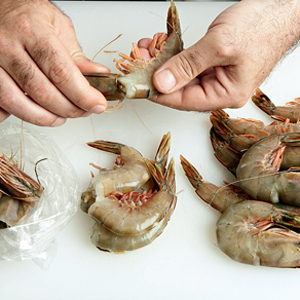Prawns are probably the most widespread and popular crustacean of all. They live in both cold and warm water and are available all year round.
Of the cold-water variety, Dublin Bay prawns (also known as langoustine or scampi) are the finest and most expensive. They should only be bought live and frisky as they are often trawled in deep water, processed and quickly frozen.
Once defrosted, they can become mushy and hard to peel and are best avoided. Of the warm-water variety, look for Giant or Black Tiger prawns, Banana prawns, King prawns or Endeavor prawns. A lot of these are trawled and kept in an ice-cold sea water slurry to keep them fresh and are mostly sold in the shell.
When choosing prawns it is preferable to buy them alive or at least fresh in the shell. The best prawns are firm, plump and translucent, with protruding eyes and feel heavy in relation to their size. Avoid prawns that are discoloured or whose eyes have collapsed – these are signs of either defrosting or old age.
Check out the great step-by-step gallery.
Prawns have a very short shelf life and deteriorate rapidly once dead. Since they do not tolerate changes in temperature or too much exposure to the air, they should be peeled, have the intestinal vein removed and then should be stored between two damp cloths in the fridge until ready to use.

